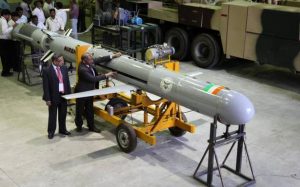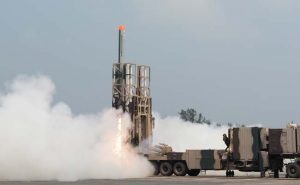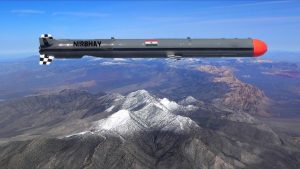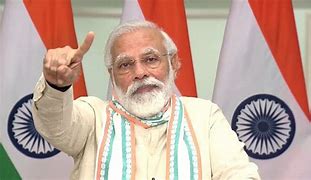Feature
India test fires long range sub-sonic cruise missile ‘Nirbhay’
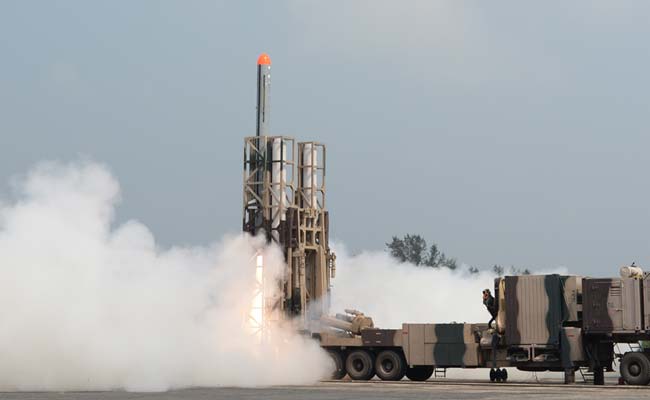
Balasore: India today conducted a flight test of its indigenously designed and developed long range sub-sonic cruise missile ‘Nirbhay’, which can carry warheads of up to 300 kg, from a test range at Chandipur along the Odisha coast.
This was the fifth experimental test of the homegrown missile system.
Defence scientists are hopeful of a flawless trial this time. Out of four earlier trials since its maiden launch in 2013, only one was successful.
The state-of-the-art sleek cruise missile took off from a specially designed launcher from the launch complex-3 of the Integrated Test Range (ITR) at Chandipur, near here, at about 11.20 AM, Defence Research and Development Organisation (DRDO) sources said.
All initial critical operations of the trial such as blast of the sophisticated missile are successful as it moved up in its trajectory, a DRDO scientist said soon after the launch of the missile.
The data is being retrieved from tracking systems for a detailed assessment, he said.
Powered by a solid rocket motor booster developed by the Advanced Systems Laboratory (ASL), the missile has an operational range of 1000 km.
‘Nirbhay’ missile can travel with a turbofan or turbojet engine and is guided by a highly advanced inertial navigation system indigenously developed by the Research Centre Imarat (RCI), the DRDO sources said.
After the missile achieves designated altitude and velocity, the booster motor is separated and the engine automatically switches on taking further propulsion, said a DRDO scientist associated with the project.
India test fires indigenously designed long range sub-sonic cruise missile ‘Nirbhay’:
He said “mid-way in its flight, the missile s wing opens up by the commands generated by the sophisticated on-board computer for stabilising the flight path.”
All along its trajectories from lift off to splash down, the missile is to be tracked with the help of ground based radars and IAF aircraft.
The health parameters of the vehicle are being monitored by indigenous telemetry stations by a team of professionals from DRDO’s ITR and LRDE (Electronics and Radar Development Establishment).
The two-stage missile is 6 metre long, 0.52 metre wide with a wing span of 2.7 metre. It can carry a warhead of 200 kg to 300 kg at a speed of 0.6 to 0.7 Mach. Its launch weight is about 1500 kg, the sources said.
A senior scientist hoped the missile would deliver the desired result this time.
“After a thorough review some changes have been incorporated in the missile system and we hope it will deliver the desired result,” said the senior scientist.
The maiden test flight of ‘Nirbhay’ held on March 12, 2013 had to be terminated midway for safety reasons due to malfunction of a component. However, the second launch on October 17, 2014 was successful, he said.
In the next trial conducted on October 16, 2015, the missile deviated from its path after covering 128 km.
The last test flight held on December 21, 2016 had to be aborted after 700 seconds of its test flight as it deviated from its designated path. All these trials were conducted from the same base at Chandipur ITR.
Also read Oxford scientists reveal Aliens looks like Human Beings
Entertainment
Meghalaya Reserves Legalized Gambling and Sports Betting for Tourists

The State Scores Extra High on Gaming-Friendly Industry Index
Meghalaya scored 92.85 out of 100 possible points in a Gaming Industry Index and proved to be India’s most gaming-friendly state following its recent profound legislation changes over the field allowing land-based and online gaming, including games of chance, under a licensing regime.
The index by the UK India Business Council (UKIBC) uses a scale of 0 to 100 to measure the level of legalisation on gambling and betting achieved by a state based on the scores over a set of seven different games – lottery, horse racing, betting on sports, poker, rummy, casino and fantasy sports
Starting from February last year, Meghalaya became the third state in India’s northeast to legalise gambling and betting after Sikkim and Nagaland. After consultations with the UKIBC, the state proceeded with the adoption of the Meghalaya Regulation of Gaming Act, 2021 and the nullification of the Meghalaya Prevention of Gambling Act, 1970. Subsequently in December, the Meghalaya Regulation of Gaming Rules, 2021 were notified and came into force.
All for the Tourists
The move to legalise and license various forms of offline and online betting and gambling in Meghalaya is aimed at boosting tourism and creating jobs, and altogether raising taxation revenues for the northeastern state. At the same time, the opportunities to bet and gamble legally will be reserved only for tourists and visitors.
“We came out with a Gaming Act and subsequently framed the Regulation of Gaming Rules, 2021. The government will accordingly issue licenses to operate games of skill and chance, both online and offline,” said James P. K. Sangma, Meghalaya State Law and Taxation Minister speaking in the capital city of Shillong. “But the legalized gambling and gaming will only be for tourists and not residents of Meghalaya,” he continued.
To be allowed to play, tourists and people visiting the state for work or business purposes will have to prove their non-resident status by presenting appropriate documents, in a process similar to a bank KYC (Know Your Customer) procedure.
Meghalaya Reaches Out to a Vast Market
With 140 millions of people in India estimated to bet regularly on sports, and a total of 370 million desi bettors around prominent sporting events, as per data from one of the latest reports by Esse N Videri, Meghalaya is set to reach out and take a piece of a vast market.
Estimates on the financial value of India’s sports betting market, combined across all types of offline channels and online sports and cricket predictions and betting platforms, speak about amounts between $130 and $150 billion (roughly between ₹9.7 and ₹11.5 lakh crore).
Andhra Pradesh, Telangana and Delhi are shown to deliver the highest number of bettors and Meghalaya can count on substantial tourists flow from their betting circles. The sports betting communities of Karnataka, Maharashtra, Uttar Pradesh and Haryana are also not to be underestimated.
Among the sports, cricket is most popular, registering 68 percent of the total bet count analyzed by Esse N Videri. Football takes second position with 11 percent of the bets, followed by betting on FIFA at 7 percent and on eCricket at 5 percent. The last position in the Top 5 of popular sports for betting in India is taken by tennis with 3 percent of the bet count.
Local Citizens will Still have Their Teer Betting
Meghalaya residents will still be permitted to participate in teer betting over arrow-shooting results. Teer is a traditional method of gambling, somewhat similar to a lottery draw, and held under the rules of the Meghalaya Regulation of the Game of Arrow Shooting and the Sale of Teer Tickets Act, 2018.
Teer includes bettors wagering on the number of arrows that reach the target which is placed about 50 meters away from a team of 20 archers positioned in a semicircle.
The archers shoot volleys of arrows at the target for ten minutes, and players place their bets choosing a number between 0 and 99 trying to guess the last two digits of the number of arrows that successfully pierce the target.
If, for example, the number of hits is 256, anyone who has bet on 56 wins an amount eight times bigger than their wager.

